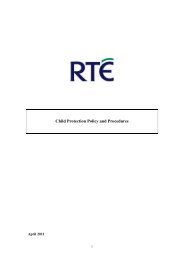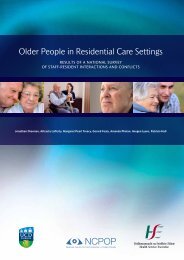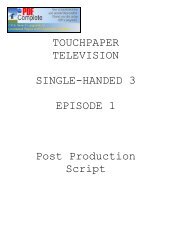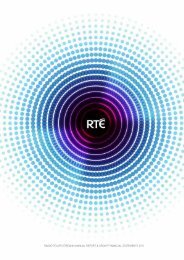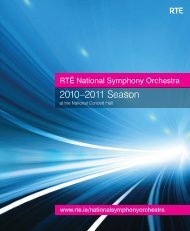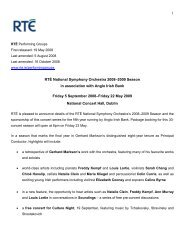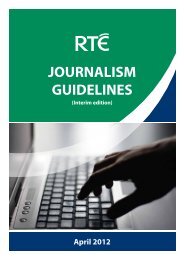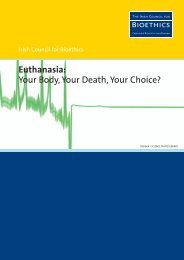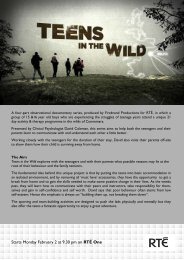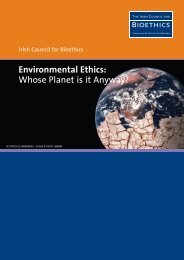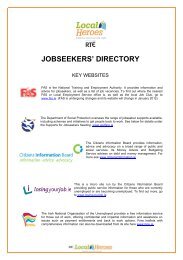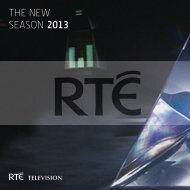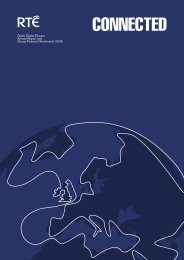Annual Reports - RTÃ
Annual Reports - RTÃ
Annual Reports - RTÃ
You also want an ePaper? Increase the reach of your titles
YUMPU automatically turns print PDFs into web optimized ePapers that Google loves.
ANNUAL REPORT & GROUP FINANCIAL STATEMENTS 2007<br />
(d) Network and facilities income<br />
Network and facilities income arises from<br />
the use of and access to, the Group’s<br />
transmission network and studio facilities<br />
provided to third parties. Amounts are<br />
recognised as the facilities are made<br />
available to third parties.<br />
(e) Circulation and events income<br />
Circulation income arises from the<br />
publication and circulation of the RTÉ<br />
Guide and is stated net of fees due to the<br />
distributor and end-retailer. Revenue is<br />
recognised on the basis of the net copies<br />
sold at the end of the sales cut-off period for<br />
each issue.<br />
Events income arises from public events<br />
organised by RTÉ Performing Groups. It<br />
is recognised as the events are held and<br />
amounts fall due.<br />
(f) Content, merchandising and<br />
related income<br />
Content, merchandising and related income<br />
represents amounts generated from RTÉ<br />
content and services provided to third parties<br />
through a range of means, including the<br />
Group’s internet facilities, Aertel teletext,<br />
the external sale of RTÉ content and<br />
amounts earned through other commercial<br />
services provided by the Group. Revenue<br />
is recognised as the service is provided or<br />
upon delivery of goods to the third party.<br />
4. Segment reporting<br />
A segment is a distinguishable component<br />
of the Group that is engaged either in<br />
providing related products or services<br />
(business segment), or in providing products<br />
or services within a particular economic<br />
environment (geographical segment), which<br />
is subject to risks and returns that are<br />
different from those of other segments.<br />
Arising from the Group’s internal<br />
organisation structure and its system of<br />
internal financial reporting, the Group’s<br />
primary reporting segment, under IAS<br />
14 Segment Reporting, is by Integrated<br />
Business Division (IBD). Each IBD is a<br />
separate division organised and managed<br />
separately according to the nature of the<br />
services and products provided.<br />
The Group has only one secondary<br />
(geographical) segment, as it currently<br />
provides its products and services exclusively<br />
within one economic environment – Ireland.<br />
5. Foreign currency transactions<br />
Transactions denominated in foreign<br />
currencies are translated to the respective<br />
functional currencies of group entities<br />
at exchange rates at the dates of the<br />
transactions. Monetary assets and liabilities<br />
denominated in foreign currencies at the<br />
reporting date are translated to the functional<br />
currency at the exchange rate at that date.<br />
Any gain or loss arising from a change in<br />
exchange rates subsequent to the date of the<br />
transaction is included as an exchange gain<br />
or loss in the Group Income Statement.<br />
Non-monetary assets and liabilities are<br />
denominated in foreign currencies that are<br />
measured at fair value are retranslated to the<br />
functional currency at the exchange at the<br />
date that the fair value was determined.<br />
6. Property, plant and equipment<br />
(a) Recognition and measurement<br />
Property, plant and equipment is shown<br />
at historical cost, net of accumulated<br />
depreciation and any accumulated<br />
impairment losses.<br />
Cost includes expenditure that is directly<br />
attributable to the acquisition of the asset.<br />
The cost of self-constructed assets includes<br />
the cost of materials and direct labour, any<br />
other costs directly attributable to bringing<br />
the asset to a working condition for its<br />
intended use, and the costs of dismantling<br />
and removing the items and restoring the<br />
site on which they are located. Purchased<br />
software that is integral to the functionality<br />
of the related equipment is capitalised as<br />
part of that equipment.<br />
Subsequent costs are included in an<br />
asset’s carrying amount or recognised as a<br />
separate asset, as appropriate, only when<br />
it is probable that future economic benefits<br />
associated with the item will flow to the<br />
Group and the cost of the replaced item<br />
can be measured reliably. All other repairs<br />
and maintenance costs are charged to the<br />
Income Statement during the financial period<br />
in which they are incurred.<br />
(b) Depreciation<br />
Depreciation is provided on all property, plant<br />
and equipment, except freehold land, at rates<br />
calculated to write off the cost, less estimated<br />
residual value, of each asset on a straight line<br />
basis over its expected useful life.<br />
The principal rates used are as follows:<br />
Buildings 2.5% – 25%<br />
Plant and equipment 7.5% – 20%<br />
Fixtures and fittings 10% – 25%<br />
Capital projects in progress represent<br />
the cost of purchasing and installing<br />
property, plant and equipment ahead of<br />
their commission into use. Depreciation<br />
is charged on assets from the date of<br />
commissioning.<br />
When parts of an item of property, plant<br />
and equipment have different useful lives,<br />
they are accounted for as separate items<br />
(major components) of property, plant and<br />
equipment and depreciated accordingly.<br />
(c) Impairment<br />
In accordance with IAS 36 Impairment of<br />
assets the carrying amount of items of<br />
buildings and plant and equipment are<br />
reviewed at each balance sheet date to<br />
determine whether there is any indication<br />
of impairment and are subjected to<br />
impairment testing when events or changes<br />
in circumstances indicate that the carrying<br />
values may not be recoverable. If any such<br />
indication exists, then the assets recoverable<br />
amount is estimated.<br />
7. Intangible assets<br />
(a) Recognition and measurement<br />
An intangible asset, which is an identifiable<br />
non-monetary asset without physical<br />
substance, is recognised to the extent<br />
that it is probable that the expected future<br />
economic benefits attributable to the asset<br />
will flow to the Group and that its cost can<br />
be measured reliably. The asset is deemed<br />
to be identifiable when it is separable or<br />
when it arises from contractual or other legal<br />
rights, regardless of whether those rights are<br />
transferable or separable from the Group or<br />
from other rights and obligations.<br />
Intangible assets are carried at cost less<br />
any accumulated amortisation and any<br />
accumulated impairment losses.<br />
The Group’s intangible assets are entirely<br />
software-related in nature.<br />
Subsequent expenditure is capitalised only<br />
when it increases the future economic<br />
benefits embodied in the specific asset to<br />
which it relates.<br />
(b) Amortisation<br />
Intangible assets, with finite useful economic<br />
lives, are amortised to the income statement<br />
on a straight line basis over their estimated<br />
useful lives from the date they are available<br />
for use. In the case of computer software,<br />
the useful economic lives are generally 3 to<br />
5 years.<br />
41



